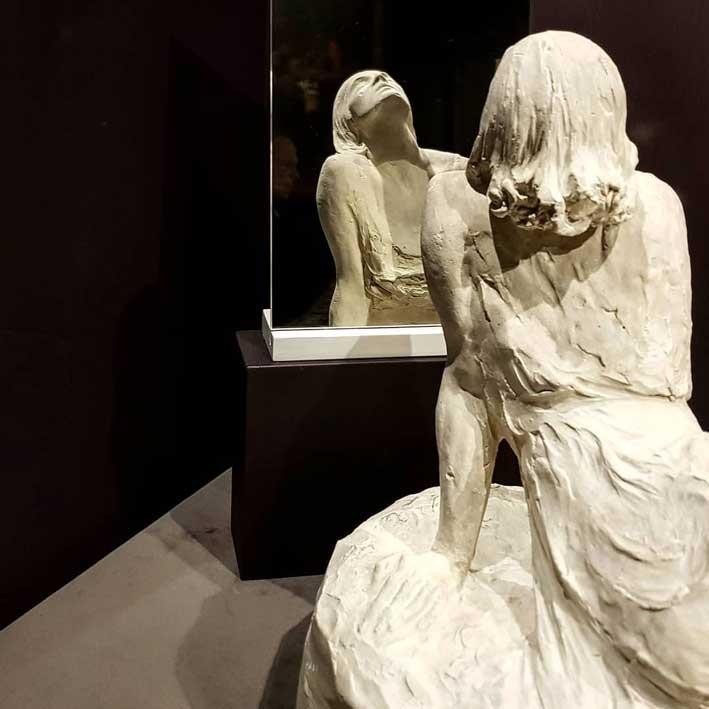While the Maltese media's focus seems to be overburdened by other cultural matters which are ongoing at present, a shining gem of an exhibition, housed within the historic house-museum of Palazzo Falson, offers a respite from the overwrought and overworked semblances of exhibitions and installations on offer this year. Titled 'The Devil of the Brush: Speed as Artistic Virtue', the exhibition focuses on a number of local cases of artistic virtuosity and bravura. Being the sixth of its series, this years' theme focuses, on a metaphysical level, on speed as an artistic experience, rather than the orthodox collection/artist-centered exhibitions hosted within this museum. This year's curator, the Baroque scholar Keith Sciberras, manages to express the fluidity of the artists' minds and the dexterity of the media represented through this comparative exhibition superbly well.
Within a small enclave of the palazzo's sprawling rooms, this exhibition manifests as a chronological explanation of Malta's salient art trends and artists. The curatorship focuses mainly on bringing to light the technical capacities of the artists in relation to the essence of speed. Therefore, this exhibition does not only explore these works of art as just objects, but unties them with the metaphysical query at hand - the speed and celerity of the artist's brush, its reception, and the final output. While most of the works exhibited are either preparatory drawings or bozzetti for larger pieces, some of these works remain as thus, an embryonic idea captured within their paper, bronze or canvas infancy. With examples ranging from the Baroque to the twentieth century, this exhibition provides a tasteful morsel of what Malta's artistic climate was and should be. In such a globalized and technologically connected world, the aspects of swift manufacturing and instant results may seem like wholly underrated aspect of production. Nonetheless, when it comes to art production, astute speed is transformed into an act of bravura and championed as a characteristic of the artist's technical surefootedness and talent.

Smudges, stray lines and even fingerprints are evident throughout most of the works. This sense of urgency - of the fleeting moments of inspiration that strike suddenly - is perhaps the main focus of this exhibition. A mix of drawings on paper, quick oil on canvas bozzetti, as well as sculptural pieces make up this exhibition. Nineteen exhibits were carefully selected, each one chosen for both their merit as well as their connection to Malta. The inherent nature of a study is that their use and purpose was to supplement the larger work that was to be completed by the artist at a later stage. Thence, both the choice of the theme as well as the artworks themselves allow a certain hidden aspect of an artist's method to be revealed and studied. While some are sourced from private collections, a few stellar works from the national collection are on show for perhaps the first time in years. Barring the ever-popular Cafà and Preti, a few overlooked works of Maltese art are laid bare for our viewing. To mind springs Antonio Sciortino's drawings for The Monument to the Unknown Soldier, a work commissioned by the British Government whilst Sciortino was the director of the British Academy of Arts in Rome. A multitude of drawings, plans and artists' rendition of this monument are currently stored in the repository of the national collection. While some showcase a high level of finish, the work chosen for this exhibition is overtly expressive in its execution. Sciortino utilised swift pencil strokes to shade the imposing façade of his proposed monument. It is juxtaposed with one of the oldest pieces on show - a drawing of St John the Baptist by Mattia Preti, produced as a study for the immense fresco ceiling cycle at the Co-Cathedral of St John. The scope of artistic and stylistic endeavour through the history of art is evident through this paragone, however the basic concept of this exhibition still applies - that is the swiftness of an artist jotting down his ideas.
Perhaps the cleverest use of the space is the way the clay bozzetto of the Charity of St Thomas Villanova by Melchiorre Cafà is exhibited. Shown from the back, therefore the most unfinished aspect of this sculpture, one can with certainty make out and follow Cafà's fingers as he molded the supple clay. Fingerprints, nail marks and other tensile movements in the medium are all a testament to this artists' dexterity and creativity. A mirror, placed directly at the back end of the case, allows the viewer to cast their gaze onto the front of the work, enabling a simultaneous view of the work of art. Other sculptural groups, such as Sciortino's Woman from Shelley are given this effect through the placement of mirrors at strategic points.
This exhibition produced a catalogue of works, including a foreword by Francesca Balzan, the museum's head curator, and two essays penned by Sciberras and Tiffany A. Racco from the National Gallery of Art in Washington DC. The exhibition has been extended and will run until the 25 March.